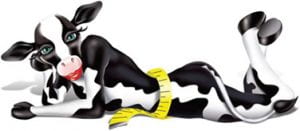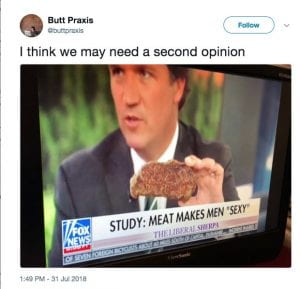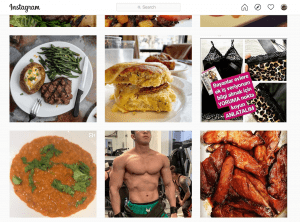Sexism is rampant in the meat industry. We know this from our readings last week, but this week in Carol J. Adams’ The Politics of Meat, we can understand this idea, and develop a framework around it through understanding her key ideas. The most important ideas from her reading include, “Meat-eating is associated with virility, masculinity. Meat eating societies gain male identification by their choice of food.” and “Women are animalized and animals are sexualized and feminized.” These ideas a fairly simple to understand and see, so let’s look at a few examples. From the list provided, I chose three examples of meat being sexualized that I thought were the strangest and funniest. First, there is this feminized cow.  What I thought was most interesting about this image is the emphasis on how thin the cow is. This is a huge juxtaposition between how we view women and how we view meat. Sexualized women are often glamorized for being thin, but cows are glamorized for being fat and providing more meat. This ad juxtaposes these ideas in a way that makes me uncomfortable. In Lisa Kemmerer’s The Pornography of Meat, an analysis of Carol J. Adams’ work, she states that “Animals are assumed to want it like women. One can consume either a pig or a woman. One can exploit and destroy a calf or a woman. ‘Because women are not being depicted, no one is seen as being harmed and so no one has to be accountable. Everyone can enjoy the degradation of women without being honest about it’” This is exactly what this image is doing, and it’s much creepier than what ‘meats’ the eye.
What I thought was most interesting about this image is the emphasis on how thin the cow is. This is a huge juxtaposition between how we view women and how we view meat. Sexualized women are often glamorized for being thin, but cows are glamorized for being fat and providing more meat. This ad juxtaposes these ideas in a way that makes me uncomfortable. In Lisa Kemmerer’s The Pornography of Meat, an analysis of Carol J. Adams’ work, she states that “Animals are assumed to want it like women. One can consume either a pig or a woman. One can exploit and destroy a calf or a woman. ‘Because women are not being depicted, no one is seen as being harmed and so no one has to be accountable. Everyone can enjoy the degradation of women without being honest about it’” This is exactly what this image is doing, and it’s much creepier than what ‘meats’ the eye.
My second image takes this idea in another strange direction, depicting the burger as a child, and the doctor as a lucky man who ‘delivered’ (?) it, and now gets to eat it. There is also this strange undertone of sexualization of birth, which again feels very strange here.
Finally, the third image I chose from the list is a Twitter post from ‘butt praxis’, questioning the validity of the sexyness of meat. I think that butt praxis makes a good point here, that this sexiness does not seem real when we think about it critically. What about meat makes men sexy? I would like a second opinion as well, preferably not affiliated with Fox News.
When I went to look for examples of this in my day to day life, I looked up the #meat on Instagram. Here are my search results:
There are two images that stand out here. There are four images of actual meat, but then a lingerie ad, as well as a picture of a regular man. I think this set of images is a perfect answer to the question ‘Who is consumed and who is the consumer?’ This average man clearly is in a dominant position, and in my search of photos of meat, there were no photos of women, but there was this ad for lingerie. As our quotes explained, women depicted to be consumed, or ‘conquered’ which results in these, frankly disgusting, and strange advertisements.






